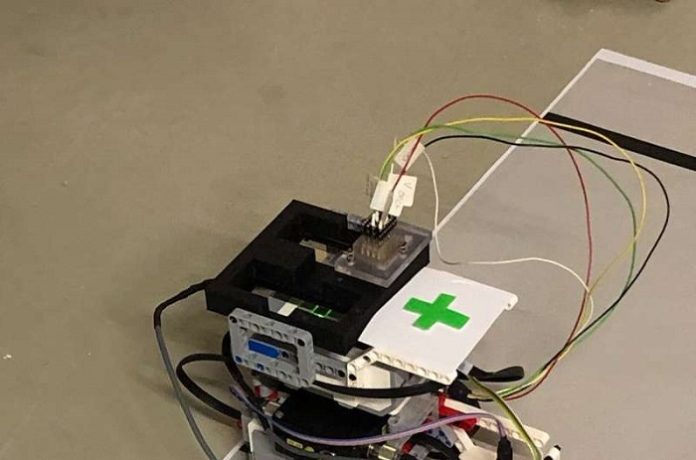Psychologists use mazes to assess the learning capacity of mice or rats. But how about robots? Can they learn to navigate the twists and turns of a labyrinth? Now, researchers at the Eindhoven University of Technology (TU/e) in the Netherlands and the Max Planck Institute for Polymer Research in Mainz, Germany, have proven they can. Their robot bases its decisions on the very system humans use to think and act: the brain. paves the way to exciting new applications of neuromorphic devices in health and beyond.
Machine learning and neural networks are applied in image recognition, medical diagnosis, e-commerce and many other fields. Still, this software-based approach to machine intelligence has its drawbacks, not least because it consumes so much energy.
This power issue is one of the reasons that researchers have been trying to develop computers that are much more energy-efficient. And to find a solution, many are finding inspiration in the human brain, a thinking machine unrivaled in its low power consumption due to how it combines memory and processing.
Neurons communicate with one another through so-called synapses, which are strengthened each time information flows through them. It is this plasticity that ensures that humans remember and learn.
“In our research, we have taken this model to develop a robot that is able to learn to move through a labyrinth,” explains Imke Krauhausen, Ph.D. student at the Department of Mechanical Engineering at TU/e and principal author of the paper.
“Just as a synapse in a mouse brain is strengthened each time it takes the correct turn in a psychologist’s maze, our device is ‘tuned’ by applying a certain amount of electricity.”
So how does it work?
The robot that Krauhausen and her colleagues used for their research is a Mindstorms EV3, a robotics kit made by Lego. Equipped with two wheels, traditional guiding software to make sure it can follow a line, and a number of reflectance and touch sensors, it was sent into a 2 m2 maze made up of black-lined hexagons in a honeycomb-like pattern.
The robot is programmed to turn right by default. Each time it reaches a dead-end or diverges from the designated path to the exit (which is indicated by visual cues), it is told to either return or turn left. This corrective stimulus is then stored in the neuromorphic device for the next effort.
“In the end, it took our robot 16 runs to find the exit successfully,” says Krauhausen (see image). “And, what’s more, once it has learned to navigate this specific route (target path 1), it can navigate any other path that it is given in one go (target path 2). So the knowledge it has acquired is generalizable.
Part of the success of the robot’s ability to learn and exit the maze lies in the unique integration of sensors and motors, according to Krauhausen, who cooperated closely with the Max Planck Institute for Polymer Research in Mainz for this research. “This sensorimotor integration, in which sense and movement reinforce one another, is also very much how nature operates, so this is what we tried to emulate in our robot.”
Smart polymers
Another clever thing about the research is the organic material used for the neuromorphic robot. This polymer (known as p(g2T-TT)) is not only stable, but it also is able to retain a large part of the specific states in which it has been tuned during the runs through the labyrinth. This ensures that the learned behavior sticks, just like neurons and synapses in a human brain remember events or actions.
The use of polymer instead of silicon in the field of neuromorphic computing was pioneered by Paschalis Gkoupidenis of the Max Planck Institute for Polymer Research in Mainz and Yoeri van de Burgt of TU/e, both co-authors of the paper.
In their research (dating from 2015 and 2017), they proved that the material can be tuned in a much larger range of conduction than inorganic materials, and that it is able to ‘remember’ or store learned states for extended periods. Since then, organic devices have become a hot topic in the field of hardware-based artificial neural networks.
Bionic hands
Polymeric materials also have the added advantage that they can be used in numerous biomedical applications. “Because of their organic nature, these smart devices can in principle be integrated with actual nerve cells. Say you lost your arm during an injury. Then you could potentially use these devices to link your body to a bionic hand,” says Krauhausen.
Another promising application of organic neuromorphic computing lies in small so-called edge computing devices where data from sensors is processed locally outside of the cloud. Van de Burgt: “This is where I see our devices going in the future. Our materials will be very useful because they are easy to tune, use much less power, and are cheap to make.”
So will neuromorphic robots one day be able to play a soccer game, just like TU/e’s successful soccer robots? Krauhausen says, “In principle, that is certainly possible. But there’s a long way to go. Our robots still rely partly on traditional software to move around. And for the neuromorphic robots to execute really complex tasks, we need to build neuromorphic networks in which many devices work together in a grid. That’s something that I will be working on in the next phase of my Ph.D. research.”








